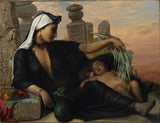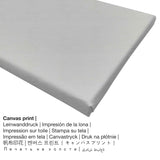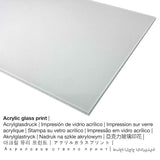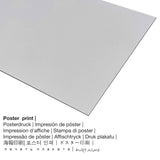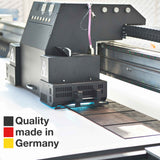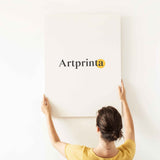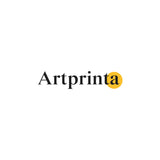Elisabeth Jerichau-Baumann, 1872 - En egyptisk Fellah-kvinne med sin baby - kunsttrykk
Mva inkludert. Frakt beregnet Ved kassen.
Informasjon om produktbakgrunnen
Det over 140 år gamle kunstverk ble skapt av realist master Elisabeth Jerichau-Baumann. This artwork belongs to the art collection of Statens Museum for Kunst (Danmarks nasjonalgalleri), which is the largest museum of fine arts in Denmark and is attached to the Danish Ministry of Culture.. The modern art public domain artpiece is being provided with courtesy of National Gallery of Denmark.The creditline of the artwork is: . What is more, the alignment of the digital reproduction is landscape and has an aspect ratio of 4: 3, noe som innebærer det lengden er 33% lengre enn bredden. The painter Elisabeth Jerichau-Baumann was a European artist from Denmark, whose style can mainly be classified as Realism. The Realist artist lived for 62 år, born in the year 1819 in Warsaw and died in 1881 in Copenhagen.
Velg alternativet for kunsttrykk
For hvert kunsttrykk tilbyr vi forskjellige materialer og størrelser. For å matche dine personlige behov perfekt, kan du velge mellom følgende alternativer for produkttilpasning:
- Lerret: The printed canvas, which shall not be mistaken with an artwork painted on a canvas, is a digital copy printed from a UV direct printing machine. The great advantage of canvas prints is that they are relatively low in weight, meaning that it is easy to hang up the Canvas print without additional wall-mounts. That is why, a canvas print is suited for any kind of wall in your house.
- Akrylglassprint (med ekte glassbelegg): A glossy acrylic glass print, often denoted as a UV print on plexiglass, changes your favorite artwork into wonderful décor and forms a good alternative option to dibond and canvas fine art replicas. The major advantage of an acrylic glass art print is that sharp contrasts as well as granular color details will be identifiable due to the fine tonal gradation.
- Aluminium dibond trykk: Aluminium Dibond prints are metal prints with a true depth effect - for a modern look and a non-reflective surface structure. For our Print On Aluminum Dibond, we print the artwork on the surface of the white-primed aluminum material. The bright & white components of the work of art shine with a silky gloss but without the glare. The colors are bright and luminous in the highest definition, the fine details of the print appear clear and crisp.
- Plakat på lerretmateriale: The poster is a printed sheet of canvas paper with a slightly rough structure on the surface. Please keep in mind, that depending on the size of the poster print we add a white margin of something between 2-6cm round about the artwork, which facilitates the framing with your custom frame.
Important information: We try what we can in order to describe the products as precisely as possible and to exhibit them visually in our shop. However, the pigments of the print products and the print result can differ to a certain extent from the representation on the device's screen. Depending on your screen settings and the condition of the surface, color pigments may not be printed as realistically as the digital version. Considering that all art prints are processed and printed manually, there may also be slight discrepancies in the motif's exact position and the size.
Strukturerte varedetaljer
| Skriv ut produkttype: | kunst reproduksjon |
| reproduksjon: | digital reproduksjon |
| Produksjonsmetode: | digitaltrykk |
| Produkt Opprinnelse: | laget i Tyskland |
| Lagertype: | produksjon på forespørsel |
| Beregnet produktbruk: | hjemmeinnredning, veggdekor |
| Bildeorientering: | liggende justering |
| Bildeforhold: | lengde til bredde 4: 3 |
| implikasjon: | lengden er 33% lengre enn bredden |
| Tilgjengelige alternativer: | akryl glass trykk (med ekte glass belegg), plakat trykk (lerret papir), metall trykk (aluminium dibond), lerret trykk |
| Lerret på båre ramme (lerretstrykk) størrelsesvarianter: | 40x30cm - 16x12 ", 80x60cm - 31x24", 120x90cm - 47x35 ", 160x120cm - 63x47" |
| Akrylglasstrykk (med ekte glassbelegg): | 40x30cm - 16x12 ", 80x60cm - 31x24", 120x90cm - 47x35 ", 160x120cm - 63x47" |
| Postervalg (lerretpapir) størrelsesalternativer: | 40x30cm - 16x12 ", 80x60cm - 31x24", 120x90cm - 47x35 " |
| Størrelser på aluminiumstrykk (aluminiumdibondmateriale): | 40x30cm - 16x12 ", 80x60cm - 31x24", 120x90cm - 47x35 " |
| Bilderamme: | ikke tilgjengelig |
Bakgrunnsinformasjon om kunstverk
| Artikkelnavn: | "An Egyptian Fellah Woman with her Baby" |
| kategorisering: | maleri |
| Generell kategori: | moderne kunst |
| Midlertidig klassifisering: | 19. århundre |
| Kunstverk år: | 1872 |
| Omtrentlig alder på kunstverk: | 140 år |
| Utstilt i: | Statens Museum for Kunst (Danmarks nasjonalgalleri) |
| Plassering av museet: | København, Danmark |
| Tilgjengelig i: | Statens Museum for Kunst (Danmarks nasjonalgalleri) |
| Lisens type kunstverk: | offentlig domene |
| Med tillatelse fra: | Danmarks nasjonalgalleri |
Artist sammendrag tabell
| Navnet på artisten: | Elisabeth Jerichau-Baumann |
| Kjønn av artisten: | mann |
| Kunstnernasjonalitet: | Dansk |
| Arbeidsplasser: | maler |
| Land for artisten: | Danmark |
| Artistkategori: | moderne kunstner |
| Kunststiler: | Realisme |
| Døde i alderen år: | 62 år |
| År født: | 1819 |
| Birthplace: | Warszawa |
| Dødsår: | 1881 |
| Døde på (sted): | København |
© Copyright av, Artprinta.com (Artprinta)
General information from Statens Museum for Kunst (National Gallery of Denmark) (© Copyright - by Statens Museum for Kunst (National Gallery of Denmark) - Statens Museum for Kunst (Danmarks nasjonalgalleri))
Baumann was a rare artist in her own day. Partly because she was a woman, but also because of her unusual openness towards the exotic and the unknown. This painting is an excellent example of Baumann’s keen sense for the erotic and the sensuous.
This painting of an Egyptian farm worker is among the most striking of Jerichau Baumann’s oriental scenes. The nudity beneath the sheer silk fabric, the exotic jewellery, the reddening evening sky, and the dark colours all infuse it with a sensuous quality that must have had a strong impact in the 1870s, a time when the body was still viewed with suspicion.
Indeed, Elisabeth Jerichau Baumann occupies a unique position within Danish post-1850 art in more ways than one. Hailing from a Polish-German background, she had a wider horizon than most Danish artists, who would primarily strive to identify and cultivate the uniquely Danish. She had an openness to all things foreign and exotic that was rarely seen in Denmark at the time; her only real match in that regard would be Hans Christian Andersen. The wanderlust of an artist took her to Turkey, Greece, and Egypt (1869-70 and 1874-75), furnishing her with a rich fount of oriental motifs.
The museum also provides interactive and video material for this artwork.

